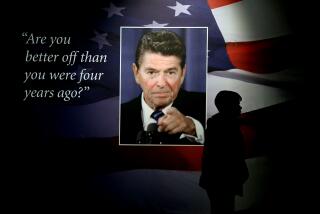Reykjavik Revisited
- Share via
If journalism is the rough draft of history, then Reagan and Gorbachev by Michael Mandelbaum and Strobe Talbott (Vintage: $5.95) is a second draft, polished and plumped up but still lacking the perspective that only true scholarship and time will bring. “Reagan and Gorbachev,” a study in superpower diplomacy during the Reagan Administration, is history hot off the press; the book is fresh enough to include the Daniloff affair and the abortive Reykjavik summit of last fall, but stops short of the Iran arms scandal--a political and diplomatic debacle that has already prompted a sudden wave of revisionism about what the media once called “the Reagan Revolution.” Still, “Reagan and Gorbachev” is useful, readable and informative--and, significantly, the book is an important reminder that Reagan is not truly a conservative in matters of foreign policy, but a radical who has challenged the most cherished assumptions of the status quo.
In a sense, “Reagan and Gorbachev” is the offspring of an intimate (and, I must say, inherently suspect) encounter between two institutions of the American democracy: the media Establishment, represented here by Talbott, Time Magazine’s Washington bureau chief, and the foreign policy Establishment in the person of Mandelbaum, a senior fellow of the Council on Foreign Relations. The authors explain that their book grew out of a “study group on U.S.-Soviet relations” sponsored by the council, one of those gatherings of eminent persons where the conventional wisdom of American politics is talked out. As a result, “Reagan and Gorbachev” embodies a kind of benchmark of foreign policy, against which Reagan is measured and found wanting.
Reagan’s failing, as we are reminded by Talbott and Mandelbaum, is that he’s a simple man, with a simplistic view of the world, whose finger is on the nuclear trigger. “Reagan and his team came into office believing that . . . the task of American foreign policy was to conduct a unilateral military buildup and go back on the offensive politically,” the authors write. The authentic Reagan, they say, is the one who decried the Soviet Union as an “evil empire.” When his political cronies (“With the support of Mrs. Reagan,” the authors report) began to worry about Reagan’s strident tone during the 1984 presidential campaign, the Great Communicator was given new lines to speak; Reagan voiced a toned-down rhetoric of “credible deterrence and peaceful competition.” But the reality of the so-called Reagan Doctrine--”Born on the beaches of Grenada in October, 1983”--was a threat to the fragile nuclear equilibrium under which we have survived since 1945: “The message of the American government was that it had both the right and the intention to seek unilateral advantages of its own, or at least to roll back the advantages the Soviets had seized in the 1970s.”
The true Reagan, we are given to understand, was the radical Reagan. “Whatever euphemism he might have adopted in the way he addressed the problem (of relations between the superpowers), he nonetheless believed that the Soviet Union was indeed both evil and an empire,” the authors write, “that it did not deserve rights and privileges equal to those accorded the United States, and that to concede such rights and privileges would be both foolish and dangerous.”
Talbott and Mandelbaum call arms control “the single most enduring piece of business that engaged the superpowers.” Reagan’s contribution to the crucial work of arms control was the so-called Strategic Defense Initiative (SDI), which the authors call “the greatest, the most controversial, and potentially the most revolutionary innovation of Reagan’s presidency.” SDI “was not the result of deep presidential immersion in the field of nuclear strategy,” Talbott and Mandelbaum observe, a bit sarcastically; rather, “It was a by-product of Reagan’s political instincts at work. . . . Bold, simple schemes worked well for him as political rhetoric.”
Reagan envisions SDI as a kind of nuclear umbrella, a sentimental and intuitively appealing image that simply ignores the technological difficulties of a “Star Wars” defense. More important, SDI is fundamentally destabilizing and threatens to reverse the momentum toward arms control.
Among the casualties of SDI, the authors point out, are the bold proposals for nuclear disarmament that were put forward at the sterile summit at Reykjavik. Still, Mandelbaum and Talbott manage to strike an optimistic note: “However fiercely they may compete elsewhere,” they write, “in conducting the nuclear arms race, the superpowers best serve their own interests by maintaining an equilibrium and jointly fostering the goal of strategic stability.” These words reflect a genuine and profound conservatism, especially when contrasted with the truly revolutionary notion of a nuclear freeze and real disarmament, and we can only pray that Reagan will hear them, and heed them.
More to Read
Sign up for our Book Club newsletter
Get the latest news, events and more from the Los Angeles Times Book Club, and help us get L.A. reading and talking.
You may occasionally receive promotional content from the Los Angeles Times.






